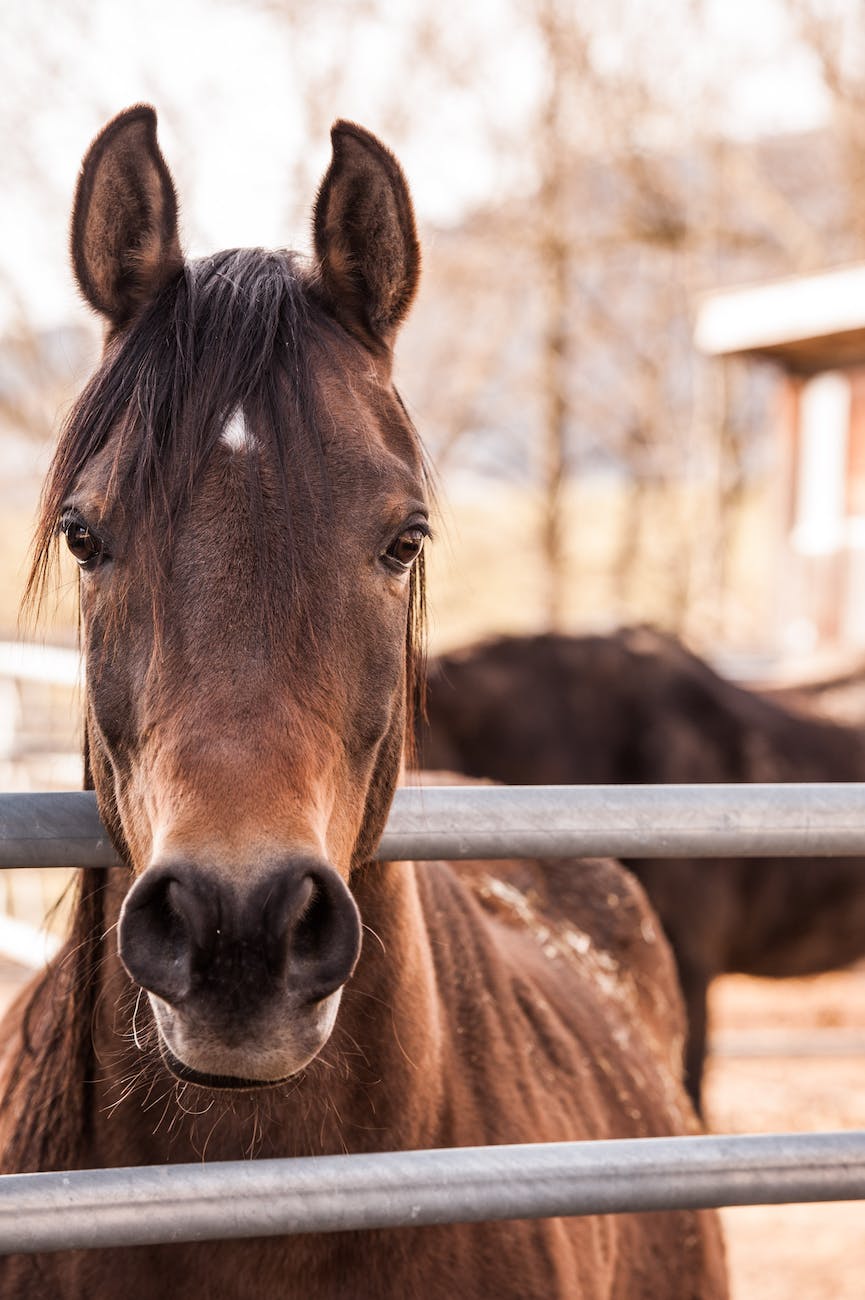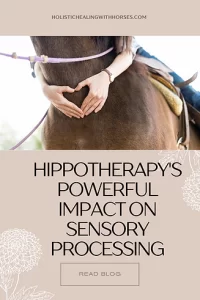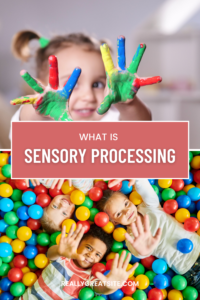
Hippotherapy Improves Sensory Processing: The Powerful Impact of the Horse
Dive into the world of sensory processing and uncover the extensive information on how hippotherapy improves sensory processing and change lives.

There is growing evidence that shows how hippotherapy improves sensory processing; however, not many people are aware of this or understand why.
I have my doctorate in occupational therapy and a strong passion educating others about how hippotherapy improves sensory processing.
I have experience practicing in multiple settings, including pediatric outpatient clinics, early intervention in the home and a daycare setting, and using hippotherapy as a treatment tool in a barn or stable.
The majority of the clients I have worked with have sensory processing difficulties, and I saw them meet their treatment goals and progress in their plan of care at such a faster rate when I incorporated hippotherapy into their treatment plan.
I’ve witnessed first hand how hippotherapy improves sensory processing.
SO WHAT IS HIPPOTHERAPY?
Hippotherapy is when a licensed therapist, typically an occupational therapist, physical therapist, or speech-language pathologist, uses the movement of the horse and the surrounding environment as a treatment strategy.
Hippotherapy is used as a part of a patient’s plan of care. For more information, check out the Information page on Holistic Healing with Horses. Before we look at how hippotherapy improves sensory processing we first need to understand sensory processing.
WHAT IS SENSORY PROCESSING?
Sensory processing is our ability to take in all of the information from our environment, make sense of it, and decide what we need to pay attention to and what we can ignore.
The ability to process sensory input from our environment directly impacts our emotions, behavior, and movement.
As children, we are taught that there are five senses: sight, smell, hearing, taste, and touch. Well, we have eight sensory systems. The three additional senses we aren’t as aware of are vestibular, proprioception, and interoception.
Our vestibular sense is our sense of movement and balance. Proprioception is our sense of deep pressure and body awareness,
Interoception is the sense of how our body feels. If you want to learn more about our sensory processing and eight senses, check out What You Need to Know About Sensory Processing

So our brain’s job is to make sense of tons of information coming from our eight senses which is a lot.
There are no breaks, and we even do this when we are asleep. Information comes into our brain, we process it, and then choose how to respond to it.
We must develop the ability to process sensory information before we can learn other skills like walking, talking, attention, following directions, and participating in our daily activities, to name a few.
Some people struggle to process and integrate all this information, making everyday activities more challenging.
If your child has sensory processing difficulties, the Out of Sync Child ? is an excellent resource for you to learn. I’d also strongly recommend talking with an occupational therapist who could help answer your questions.
WHY HIPPOTHERAPY IMPROVES SENSORY PROCESSING
Why hippotherapy improves sensory processing. Well, one of the most essential aspects of hippotherapy is the movement of the horse.
The horse has a rhythmic stride that moves the client’s hips and pelvis in the same way as they would be if they were walking. The horse’s stride is four beats: 1, 2, 3,4, 1, 2, 3, 4, 1, 2, 3, 4.c
During a 45-minute session, the horse takes several thousand strides offering the client several thousand repetitions of this movement. This is unheard of in other therapy settings. The client receives a significant amount of vestibular input during one therapy session.
The therapist considers the client’s sensory needs when using the horse’s movement in therapy. If the goal is to calm the sensory system, the therapist can have the horse walk consistently, providing the client with a rhythmic consistent movement that calms the nervous system.
If the therapist wants to provide the client with more input to increase their arousal level and response, they can have the horse start and stop, walk fast then slow, or have them do big or small turns.
The therapist’s goal is to understand the client’s sensory needs, design the treatment session to meet their needs and help them reach a state of regulation and achieve their goals.
THE ENVIRONMENT OF A HIPPOTHERAPY SESSION
When using hippotherapy as part of a treatment session to help clients improve their sensory processing needs, there is more to consider than just the horse’s movement. The environment the hippotherapy session takes place in plays a significant part in the plan of care.
Hippotherapy sessions occur in two locations, either outside or in an indoor arena. These settings are considered outdoors and are, therefore, more natural environments.
The environment has natural lighting and other natural elements such as wind, smell, and sights. Horses are very calming animals as well, so it’s often calming for clients to be in the same environment as them
Being outdoors is the most calming environment from a sensory processing standpoint. Our nervous systems respond well to being outside. The environment of a hippotherapy session is calming for the clients.
In most cases, it is also a new environment. Unless the client lives or spends much time at a farm or around animals, the sensory input they receive during a hippotherapy session is often unlike the sensory input they receive during their typical everyday routine.
This is important because providing our nervous system with novel sensory input challenges our sensory processing skills in new ways. This has the potential to help us be more efficient and skillful at processing our sensory information from our environment.
Therapists who are working with clients who have sensory processing needs want to offer clients opportunities to explore new sensory experiences while making sure the client feels safe, comfortable, and in control. Incorporating hippotherapy into a treatment session is a great way to do this.
MOTIVATION IS KEY!
Hippotherapy can be beneficial for so many individuals because it is extremely motivating. It often is enjoyable for the client, and they have fun during their sessions. For most, it doesn’t even feel like therapy to them. It’s not therapy. I’m riding a horse!
Occupational therapists often consider motivating activities to be a part of their treatment plans for their clients. We know that the client is more likely to progress in therapy if they are motivated by the therapeutic activities they are participating in.
Clients will also be more willing to engage in challenging activities if they enjoy them. This is part of the reason why hippotherapy is so beneficial for so many.
EVIDENCE-BASED PRACTICE!
Ok, if you still aren’t convinced that hippotherapy improves sensory processing difficulties, check out the Research page on Holistic Healing with horses.
Here there are short summaries of the evidence that supports the benefits of hippotherapy for those with sensory processing needs. You can also find supportive research on not only sensory processing but other disabilities and diagnoses as well.
Horses can be a powerful tool in a treatment session to help many people achieve their goals. Occupational therapists use horses in hippotherapy sessions to help individuals improve their sensory processing skills.
I’ve witnessed so many individuals make life-changing improvements with this type of treatment strategy.
One of the reasons I love helping clients improve their sensory processing skills so much is that when you see an individual’s sensory processing skills improve, you begin to see other areas in their life improve as well. Hippotherapy can be at the start of this.
Please leave your questions and comments belo
